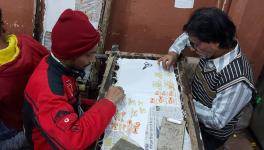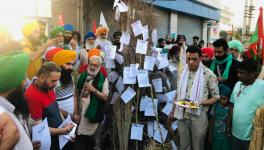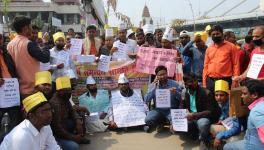Where Gulal Comes From: Vrindavan’s Widows Abandoned by Families

Widows participate in Holi celebrations at the ancient Gopinath Temple during an event organized by Sulabh International, in Vrindavan, Monday, March 6, 2023. Image Courtesy: PTI
Banke Bihari temple is one of the most popular tourist attractions in the temple town of Vrindavan. Most tourists arrive here carrying garlands of flowers for the deity, Banke Bihari. Instead of discarding them to end up in garbage dumps, as has been the practice, the temple management collects and sends them to the Mahila Ashray Sadan at Chaitanya Vihar in the town, home to 375 widows aged 60 to 95 years. The Sadan has arranged for a local NGO, the Braj Gandha Prasar Samiti Ashram, to train these women—nicknamed “mothers”—to manufacture Holi colours or gulal from these flowers. Aarti, who heads a group of volunteers of BGPS, proudly speaks of their endeavour: “We make the purest gulal in the Braj region of Uttar Pradesh. We pay the mothers for their work—those whose health allows them to work—and they are delighted with the additional income.”
Making gulal is a complicated process that involves separating the flower petals, drying, crushing them to extract colour, then straining and mixing a dash of perfume—which comes in large containers all the way from Kannauj in the Awadh region.
Shivani, a widow from Murshidabad in West Bengal, would beg on the streets of Vrindavan before this shelter took her in. Now she helps make this gulal, which is sold commercially. “I earn Rs 50 a day, which helps me buy many household items I require,” she says.
At 60, Shivani is among the few who have found a government-run shelter to live in, but it took the Supreme Court’s intervention to ensure all widows receive a Rs 1,850 monthly income to pay for food. Women also get free rice and wheat from the government’s food distribution program. The majority, however, must make their own arrangements for stoves and cooking gas cylinders. The Akshaya Patra Foundation provides them with one hot meal, and they are supplied five litres of drinking water daily because the tap water in Vrindavan is salty.
The BGPS also helps women learn how to make agarbatti and paper bags. These, too, are sold on a commercial basis. Aarti says, “Teaching the mothers requires a great deal of patience. Many still relive the trauma of their earlier lives. They tire easily and need frequent breaks,” she says.
Pushpa Mandal, 65, also from West Bengal, has lived in Vrindavan for 18 years. She left her home after facing continuous ill-treatment at the hands of her two sons. She has mastered the art of making agarbattis. Confidently, she says, “We have been told our agarbatti has a beautiful fragrance.” But work is also a struggle as she is unable to work more than two hours a day—“I get tired. I need to keep resting.”
The other government-run ashram for widows in Vrindavan is Krishna Kutir, which houses 175 widows though it has room for 1,000. Some of the residents have been trained to manufacture agarbatti, pickle and paper bags, but it isn’t very popular since it is far from the heart of Vrindavan, where its many temples are.
A few years ago, homelessness was the norm among Vrindavan’s widows. Things were so bad, when they died, their bodies were thrown into the Yamuna river. Mohini Giri, a former chairperson of the National Commission for Women, who heads the NGO Guild of Service these days, runs a shelter home in Vrindavan. During a visit to Vrindavan two decades ago, she saw a deceased woman—one of its ubiquitous widows—consumed by vultures on the street. She was even more horrified that nobody would touch this abandoned woman’s body, for widows are considered outcasts. Giri moved the Supreme Court against the atrocious conditions, and it ruled that it is the government’s responsibility to feed and shelter widows and provide them with a dignified cremation.
Moved by her Vrindavan experience, Giri started the Ma Dham Mahila Ashram, just beyond the main city limits. Its beautiful gardens allow its 58 inmates to take pleasant walks in the mornings and evenings. The women living in the ashram are encouraged to wear coloured clothes, moving away from the traditional white-only that widows are made to wear, and to sport a bindi, a sign of marriage, and wear bangles, which also married women are traditionally wear. They also receive small sums of money if they engage in any of the jobs provided within the ashram.
“Each woman has a small patch of land she takes care of. We run a day school and pay the women who help run it. But this is not easy because seven years ago, the Yogi [Adityanath] government stopped paying the institute the grant it was receiving,” Giri says. The women also need regular counselling and encouragement to keep working after their bitter life experiences.
Kaajal, a councillor in Mathura, commutes to the ashram every day. She says the women have a multitude of anxieties. “Our group therapy sessions emphasise the need to do some work to help them recover from traumas,” she says. “Many try, but they don’t always succeed.”
Sunaina “ma” from the Nalanda district of Bihar came to Vrindavan after her husband and two sons died. She had no family left. “With no one left to turn to, I made my way to Vrindavan and have lived here for 27 years. I would beg outside temples to earn a little, but now I live here,” she says.
Seventy-two-year-old Shyam Bai from Chhattisgarh describes her equally traumatic life. After her husband died, she lost her daughter to cancer, and her son died in an accident. She says, “A local broker encouraged me to sell my house in the village. I agreed, but he cheated me of the sale money.” Eight years ago, the broker brought her to Vrindavan and abandoned her, a penniless old woman, at the gates of the well-known Shri Radha Madan Mohan temple. It’s a situation that thousands of Indian widows confront across the country, filling up temple towns and ashrams within, robbing them of the chance to live independent lives.
“Their experiences have made it very difficult for some of these women to find the motivation to work. They find solace in prayer and bhajan,” says Kajal.
India has around 40 million widows and, apart from a small monthly pension from State governments, which is typically erratic, they mostly live in penury. There are no exact figures on how many widows live in Vrindavan, but the government estimates there are 3,000. NGOs claim the actual figure is at least five times higher.
The Holi festival marks a break from the routine existence of Vrindavan’s widows. They await this day eagerly. On the day before Holi, they get a new sari, a small box of gulal, and sweets. At the Ma Dham ashram, they play Holi in the large gardens surrounding the building.
Some women have shown great fighting spirit despite their many challenges. Take Radha Kundi, whose Aadhaar card shows she is 108 years old. The oldest inmate of the ashram, she describes growing up in West Bengal and witnessing both world wars. Giri believes Kundi’s age in the card is quite accurate, given that her granddaughter is over 50 and two great-grandchildren are in their twenties. “I love chatting with other women and eating salty namkeen,” the octogenarian told me, excitedly looking forward to another Holi celebration in Vrindavan.
The author is an independent journalist. The views are personal.
Get the latest reports & analysis with people's perspective on Protests, movements & deep analytical videos, discussions of the current affairs in your Telegram app. Subscribe to NewsClick's Telegram channel & get Real-Time updates on stories, as they get published on our website.






















